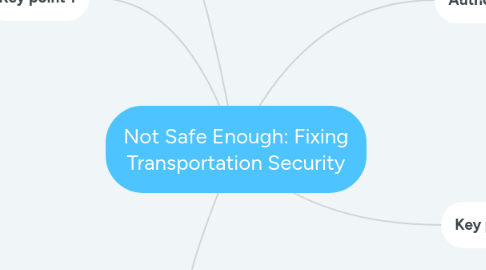
1. Overview
1.1. Issue
1.1.1. Transportation security that have been implemented is not safe enough due to lack of money and resources.
1.2. Author's POV
1.2.1. The transportation security have not been upgraded.
2. Key point 1
2.1. General aviation has not been substantially upgraded.
2.1.1. Supporting details
2.1.1.1. -There is no security screening for pilots and passengers or for baggage and cargo.
2.1.1.2. -Threat and vulnerability assessments have yet to be undertaken for most general aviation airports.
2.1.1.3. -Similar shortcomings continue to exist in air cargo security.
2.1.2. Strong evidence
2.1.2.1. -Reportedly, only 5% of all air cargo is currently screened, and the Government Accountability Office(GAO) has indicated that aircraft carrying cargo continue to be highly vulnerable to terrorist sabotage.
2.1.2.2. -TSA has proposed a set of regulations for air cargo security, but as is typical for rulemaking, the process is moving very slowly.
3. Key point 2
3.1. Difficulties in trying to fulfill the new responsibilities for port security.
3.1.1. Supporting details
3.1.1.1. -The DHS inspector general, the GAO and its own commandant have difficulties to fulfill the new responsibilities together with its traditional rescue, drug-interdiction and other mission under current funding levels.
3.1.2. Strong evidence
3.1.2.1. -A 2005 maritime security report observed that " A compressed and disjointed timeline for implementing the act has definitely affected what the Maritime Transportation Security Administration(MTSA) has actually accomplished."
3.1.2.2. "Overall, too many facility plans are little more than lists of activities that individually and collectively fall far short of the goals set by MTSA."
4. Author's Tone
4.1. To inform
5. Key point 3
5.1. TSA and DHS continue to play a minimal part in land transportation security due to low budgets.
5.1.1. Supporting details
5.1.1.1. -These limited federal investments, directed primarily at rail and transit systems, have financed number of security measures including vulnerability, increased law enforcement presence, enhanced surveillance, expanded worker security training and limited deployment of explosives-detection capability such as canine teams.
5.1.1.2. -However,with an almost complete absence of data on the effectiveness of these measures, it is difficult to discern what impact they have had.
5.1.1.3. -Due to a lack of resources, land transportation security efforts have been hindered by poorly defined roles and responsibilities for the federal agencies involved, inadequate policy planning, limited information sharing and insufficient security training for front-line personnel.
5.1.2. Strong evidence
5.1.2.1. -The Department of Transportation(DOT), land-transportation modal agencies including the Federal Railroad Administration, the Federal Transit Administration, the Federal Highway Administration and the Federal Motor Carrier Safety Administration have retained substantial security roles but these too are operating with very limited resources which is less than $60 million overall in the current budget.

